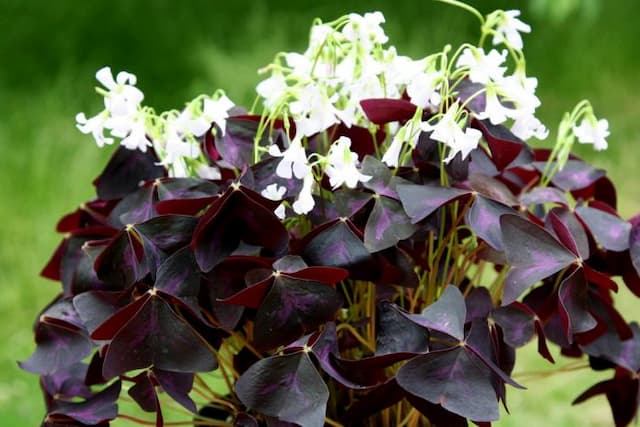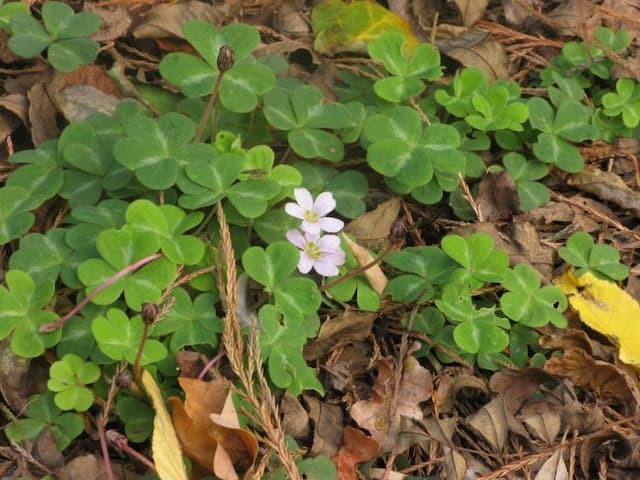Silver Shamrock Oxalis adenophylla

ABOUT
The plant known as Silver Shamrock showcases a charming clump of foliage comprising gray-green leaves that have the look of clover. Each leaf is made up of several heart-shaped leaflets arranged in a radial pattern, resembling a delicate floral rosette. The Silver Shamrock blooms with an abundance of flowers that rise above the foliage on slender stalks. These blossoms are notable for their soft pink to lilac shades, with deeper colored veins running through the petals, creating an enchanting contrast with the foliage. The flowers open wide under the sun, revealing their beauty, and tend to close in the evening or on cloudy days.
About this plant
 Names
NamesFamily
Oxalidaceae
Synonyms
Silver Shamrock, Chilean Oxalis, Pink Buttercups
Common names
Acetosella adenophylla, Oxalis adenophylla var. albicans, Oxalis alpina, Oxalis enneaphylla var. adenophylla.
 Toxicity
ToxicityTo humans
Oxalis adenophylla, commonly known as silver shamrock, is considered to have a low level of toxicity to humans. It contains oxalic acid and its soluble salts, which, when ingested in significant amounts, can bind with calcium to form calcium oxalate crystals. This can potentially lead to symptoms such as irritation in the mouth, throat, and gastrointestinal tract, resulting in abdominal pain, nausea, vomiting, and diarrhea. In most cases, accidental consumption of small quantities is unlikely to cause severe problems, but it is advisable to avoid ingestion and to keep the plant out of reach of children who might be tempted to eat it.
To pets
Silver shamrock, the common name for Oxalis adenophylla, is also toxic to pets, including cats and dogs, due to the presence of oxalates in the plant. Similar to its effects in humans, ingestion of the plant by pets can result in symptoms like excessive drooling, vomiting, diarrhea, decreased appetite, and abdominal pain. In severe cases, particularly if a large amount is consumed, it may lead to more serious symptoms due to the formation of calcium oxalate crystals, which can disrupt the normal function of various organs. Pet owners should keep this plant out of reach of their animals and seek veterinary care if they suspect their pet has ingested any part of it.
 Characteristics
CharacteristicsLife cycle
Perennials
Foliage type
Deciduous
Color of leaves
Green
Flower color
Pink
Height
0.1 feet (3 cm
Spread
0.5 feet (15 cm
Plant type
Bulb
Hardiness zones
7
Native area
South America
Benefits
 General Benefits
General Benefits- Ornamental value: Silver Shamrock (Oxalis adenophylla) is prized for its attractive foliage and delicate pinkish-white blossoms that enhance garden aesthetics.
- Low maintenance: It is generally easy to care for and doesn't require frequent watering, making it suitable for gardeners seeking minimal upkeep plants.
- Drought tolerance: Silver Shamrock exhibits drought-resistant traits once established, making it a suitable choice for xeriscaping and arid climate gardens.
- Ground cover: The plant spreads over time, covering ground effectively and helping to prevent weeds in the garden by occupying the space that weeds might otherwise take.
- Cold hardiness: Silver Shamrock is capable of withstanding cold temperatures, which makes it a suitable choice for gardens in cooler climates.
- Attracts pollinators: The flowers of Silver Shamrock attract bees and other pollinators, promoting biodiversity in the garden.
- Edible parts: Some parts of the plant are edible and can be used in small quantities to add a sour taste to salads and other dishes; however, they should be consumed in moderation due to the presence of oxalic acid.
 Medical Properties
Medical PropertiesThis plant is not used for medical purposes.
 Air-purifying Qualities
Air-purifying QualitiesThis plant is not specifically known for air purifying qualities.
 Other Uses
Other Uses- Oxalis adenophylla, commonly known as the Silver Shamrock, can be used as a natural dye, providing a range of colors from yellow to green, depending on the mordant used.
- Its sour-tasting leaves, high in oxalic acid, are sometimes used in small quantities to add a lemony flavor to salads.
- The plant's showy flowers are often used in ornamental floral arrangements or to add splashes of color to rock gardens.
- As a low-growing plant, the Silver Shamrock is used as living mulch to suppress weeds and retain soil moisture in garden beds.
- Its hardiness and ability to tolerate poor soils make it suitable for soil erosion control in landscape restoration projects.
- Gardeners may use the plant's natural tendency to spread as a ground cover to fill in spaces between stepping stones or pavers.
- In colder climates, the Silver Shamrock is sometimes grown as a container plant, bringing a touch of spring to indoor settings with its delicate pink or white flowers.
- The contrasting foliage and flowers can be utilized in fairy gardens to create whimsical miniature landscapes.
- Its ability to grow in alpine conditions makes it ideal for educational purposes in school projects focusing on mountainous plant life.
- Photographers and artists might use the pleasing aesthetic of the Silver Shamrock as a subject in their work to capture the beauty of natural geometry.
Interesting Facts
 Feng Shui
Feng ShuiThe Silver Shamrock is not used in Feng Shui practice.
 Zodiac Sign Compitability
Zodiac Sign CompitabilityThe Silver Shamrock is not used in astrology practice.
 Plant Symbolism
Plant Symbolism- Good Luck – Oxalis, commonly known as wood-sorrel or shamrock, is often associated with good luck due to its resemblance to the four-leaf clover.
- Happiness – The bright and cheerful appearance of the Oxalis flowers are symbolic of joy and happiness.
- Resilience – Oxalis plants can thrive in a variety of conditions, which makes them a symbol of resilience and adaptability.
 Water
WaterSilver Shamrock requires moderate watering, being careful not to overwater as it prefers well-drained soil. During active growth in spring and summer, water when the top inch of soil feels dry, approximately once or twice a week, using about 8-16 ounces of water depending on the pot size. In fall and winter, reduce watering to once every two to three weeks, as the plant enters a dormant period.
 Light
LightSilver Shamrock thrives in bright, indirect light but can tolerate partial shade. The best spot for this plant would be in an east- or west-facing room where it receives some gentle morning or late afternoon sun. Avoid direct, harsh sunlight, especially during the peak hours of the day, to prevent leaf burn.
 Temperature
TemperatureSilver Shamrock prefers cooler temperatures and can tolerate a range from 50°F to 75°F, making it a suitable indoor plant in most climates. It's important to avoid extreme temperatures; do not expose the Silver Shamrock to temperatures below 50°F or above 80°F for prolonged periods. The ideal temperature range for this plant would be between 60°F and 70°F for optimal growth.
 Pruning
PruningPruning is essential for maintaining the Silver Shamrock's compact, lush appearance. Trim off any dead or yellowing leaves at their base as needed to encourage healthy growth and improve air circulation. The best time for pruning is in the late winter or early spring before new growth begins.
 Cleaning
CleaningAs needed
 Soil
SoilThe silver shamrock (Oxalis adenophylla) thrives in a well-draining soil mix consisting of 50% standard potting soil and 50% perlite or coarse sand. This plant prefers acidic to neutral soil with a pH between 5.5 and 7.
 Repotting
RepottingSilver shamrocks should be repotted every two to three years or when they appear to be outgrowing their current container.
 Humidity & Misting
Humidity & MistingSilver shamrocks prefer moderate humidity levels; aim to provide a humidity level around 50%.
 Suitable locations
Suitable locationsIndoor
Place in bright, indirect light and keep it in cool conditions.
Outdoor
Plant in part shade; ensure well-draining soil.
Hardiness zone
4-9 USDA
 Life cycle
Life cycleChilean oxalis (Oxalis adenophylla) begins its life cycle as a seed, which germinates in moist, cool conditions, typically in the spring. The seedling grows into a bulb-like structure known as a corm, from which foliage and a flowering stem will eventually emerge. The foliage consists of clover-like leaves that capture sunlight and energy through photosynthesis. Following vegetative growth, the plant produces pink or white flowers, which are pollinated by insects, leading to the formation of seed capsules. After flowering, the plant goes into dormancy, with the corm surviving underground through adverse conditions, such as winter. The cycle resumes with new vegetative growth in the next favorable season, completing the annual or perennial lifecycle of the plant.
 Propogation
PropogationPropogation time
Spring-early summer
The most popular method of propagation for Oxalis adenophylla, also known as Silver Shamrock, is through division of the bulbs. This is typically done in the fall, after the plant has finished flowering and has begun to go dormant. Gardeners should carefully dig up the bulbs and gently separate them, making sure that each division has at least one growth point. These divisions can then be immediately replanted at a depth of approximately 1 inch (2.54 cm), spaced around 3 inches (7.62 cm) apart, in well-draining soil. The newly planted bulbs should be watered thoroughly to help establish them. This method allows for a relatively quick increase in the number of plants and is an easy and efficient way to propagate Silver Shamrock.




